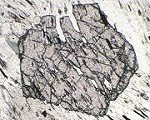Practical Aspects of Mineral Thermobarometry
Ideal Mixing on Sites: the ionic model
In what follows we assume ionic mixing on sites, i.e. that cations mix with others over particular crystallographic sites in a mineral structure. Initially, we shall assume ideal mixing, i.e. that there is no enthalpy of mixing, and the free energy of mixing is determined only by the configurational entropy of mixing.
One-site substitution
Where substitution occurs on one site per formula unit, e.g. (Ca, Mg, Fe) CO3
ai = Xi
where X is the mol fraction of component i.
Multi-site substitutions
On one type of site [Spear, p. 180]
If there are two sites (of the same type) per formula unit, as in simple olivines, (Mg,Fe)2SiO4, then for forsterite:
µfo = µ°fo + 2RTlnXfo.
Therefore, for ideal mixing, a = X2. In general, where cation j mixes with others on a sites in the formula unit, the activity of the j-rich end member i is
![]()
The activity of grossular Ca3Al2Si3O12 in grossular - almandine - pyrope garnet is therefore
agrs = (XCa)3, i.e. RTln(agrs) = 3RTln(XCa)
where XCa = Ca/(Ca+Fe+Mg+Mn), or, if cations are already suitably normalised, XCa = Ca/3.
Mixing on several sites [Spear pp. 183-186]
For the case where substitutions take place on two different sites, take the example of sodic augite (Ca,Na)M2(Mg,Fe,Al)M1Si2O6 (where the superscripts M2 and M1 denote the two distinct types of site in the clinopyroxene structure). Assuming that the mixing on each site is random and independent of the occupancy in the other type of site, the expression for the chemical potential of diopside CaMgSi2O6 in augite would be
µdi = µ°di + RTlnXCa,M2 + RTlnXMg,M1.
Therefore, the activity of diopside adi = XCa,M2.XMg,M1, the product of the mole fractions of the relevant cations in each site.
In general, then, we multiply site fractions together to obtain ideal activities. Some authors call these activities thermodynamic mole fractions, and the model is commonly called mixing-on-sites.
More complex examples
Many of the minerals of interest to us involve substitutions on several sites. Moreover there may be charge-balance or other considerations that indicate that the mixing on different types of site is not independent. In these cases some care is necessary in choosing the most appropriate activity model.
Calcium tschermak's pyroxene: [Spear pp. 186-188]
This example introduces normalisation constants, which are necessary
when an end member contains a site occupied by more than one type of
cation, and investigates how different a-X models result from
different assumptions about the nature of the Ca-tschermak's end
member; and the way in which mixing occurs.
Plagioclase and Al-avoidance [Spear 188-190]
Consideration of the state of ordering in the end members is even
more important in the plagioclase series. Check out this example.
Activity expressions for commonly-used end members
The following table lists activity expressions, mostly taken from Holland and Powell (1990) p.100. In many cases, these activity models were used in the derivation of thermodynamic data for these end members in the Holland and Powell dataset, and so the same models must be used when the data are re-applied in calculations.
| End Member | Formula | Activity expression |
|---|---|---|
| Micas | ||
| muscovite | KVAl2Si2[SiAl]O10(OH)2 | 4(XK,A)(XV,M1)(XAl,M2)2(XAl,T2)(XSi,T2) |
| celadonite | KV[AlMg]Si2Si2O10(OH)2 | 4(XK,A)(XV,M1)(XMg,M2)(XAl,M2)(XSi,T2)2 |
| phlogopite | KMgMg2Si2Si2O10(OH)2 | 4(XK,A)(XMg,M1)(XMg,M2)2(XAl,T2)(XSi,T2) |
| eastonite | KMg[MgAl]Al2Si2O10(OH)2 | 4(XK,A)(XMg,M1)(XMg,M2)(XAl,M2)(XAl,T2)2 |
| Chlorites | ||
| clinochlore | Mg4[MgAl]Si2[AlSi]O10(OH)8 | 16(XMgM1)4(XMg,M2)(XAl,M2)(XAl,T2)(XSi,T2) |
| amesite | Mg4Al2Si2Al2O10(OH)8 | (XMgM1)4(XAl,M2)2(XAl,T2)2 |
| Amphiboles | ||
| tremolite | VCa2Mg3Mg2Si4Si4O22(OH)2 | (XV,A)(XCa,M4)2(XMg,M13)3(XMg,M2)2(XSi,T2)4 |
| tschermakite | VCa2Mg3Al2Si4[Al2Si2]O22(OH)2 | 16(XV,A)(XCa,M4)2(XMg,M13)3(XAl,M2)2(XAl,T2)2(XSi,T2)2 |
| pargasite | NaCa2Mg3[MgAl]Si4[Al2Si2]O22(OH)2 | 64(XNa,A)(XCa,M4)2(XMg,M13)3(XMg,M2)(XAl,M2)(XAl,T2)2(XSi,T2)2 |
Check that you understand how these formulations were arrived at. Although they look complicated, some lead to activity-composition relationships which are fairly close to ideal.
This page last modified 12 October 2004
